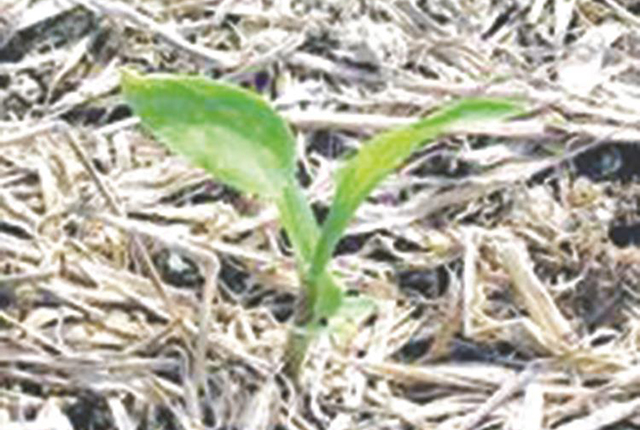Moisture control key to agric success


Conservation agriculture contributes to increases in soil moisture attributed to crop residue on soil surfaces
Ronald Rusere Correspondent—
As we gear up for the rainy season with some areas already receiving significant rains this week, it is important that farmers take note of a key issue in increasing crop productivity by improving rain water use efficiency in under unpredictable weather conditions. Regarding rain-fed or dryland farming, which a larger proportion of Zimbabwean farmers are by and large tied to, crop production is heavily dependent on in-season spatial and temporal distribution of rainfall.
In Zimbabwe the crop growing period normally extends from November to April and rainfall normally occurs as short duration, heavy convective storms during this period.
Due to climate change, we are now witnessing rainfall occurrences which are poorly distributed during the growing period, taking more than three weeks between successive rainfall events in some seasons.
Such mid-season dry spells are now a characteristic feature in parts of Zimbabwe and the impact of such dry spells on farmers is sometimes more severe than that of drought.
It is common knowledge that not all rainfall that falls in a field is effectively utilised by a crop for growth and development. Soil water management in rainfed farming has the potential of reducing the negative impact of mid-season dry spells.
Soil is the medium for water storage and supply to growing crops in farming systems, and sustainable soil water management is therefore critical in farming systems.
It should be emphasised that the shortage of water in rainfed agriculture is not always caused by low rainfall as generally perceived but rather by lack of sustainable management and use of available rainwater.
In Zimbabwe the growing-season rainfall can vary markedly from year to year. No two seasons are the same. This leads to rainfall variability from one year to the next.
The goal for every farmer is capturing enough rain for crop growth and lengthening the period that moisture lasts in the soil. The more rainfall water that can be retained in the soil, the more there is available for crop production.
It is important that farmers take measures to reduce losses which occur in fields through any of runoff, seepage, and evaporation and transpiration by weeds. A fraction of heavy, high intensity rain percolates into the soil and can be stored in the crop root zone, hence the efficacy of this type of rainfall is low.
Approximately 8mm/day of rainfall can be lost via evaporation on soils surfaces which lack cover or crop residue.
In the absence of effective moisture conservation in fields, even as much as 60 percent of rainfall can be lost through runoff and evaporation in areas which receive low rainfall.
When rain falls on the soil surface, part of it will infiltrate into the soil to replenish soil water or flow through to recharge the groundwater, some will be lost via runoff and the remainder will evaporate directly from unprotected soil surfaces and from crop leaves.
Farmers can adopt practices that lengthen the duration of soil moisture availability in the soil, enhance infiltration of rainwater into the soil and can also store surface and sub-surface runoff water for later use such as rainwater harvesting systems with storage for supplementary irrigation. Optimisation of soil moisture can be achieved by adopting practices which ensure that the primary route for water out of the soil is through the crop through transpiration.
The goal for soil water management, therefore, is a reduction in evaporation losses while increasing the flow of water via crop transpiration.
Adoption of farming practices that promote this differential water movement enhances sustainability. The more rainfall water that can be retained in the soil, the more there is available for crop production. The goal for every farmer is capturing enough rain water for crop growth and lengthening the period that moisture lasts in the soil. There are agronomic options in abundance that can aid in improving rainfall use efficiency under dryland farming.
Cultural practices such as minimum tillage, appropriate fertiliser use, improved weed control, timely planting, in conjunction with the use of drought tolerant varieties, have the potential to cause yield increases as well as rainfall use efficiency under rainfed crops.
These practices lead to decreased water losses due to soil evaporation, overland flow, deep percolation, and effect of weeds competing for water, thereby increasing water availability for crop use. Maximising rainfall use efficiency to produce high crop yields is of paramount importance.
Planting densities can be used as a way to offset limited water supply.
Plant spacing refers to the distance between rows and between plants in the rows. The closer the spacing the higher the number of plants per hectare. In drier areas wider spacings are preferable in order to supply more soil water to the individual crop and in high rainfall areas closer spacings are possible.
Efficient precipitation utilisation also requires that the plant population density should be matched with the water supply, which is determined by the stored soil water at planting plus the expected rainfall.
Tillage can be implemented that reduces runoff and increases infiltration. Conservation agriculture contributes to increases in soil moisture attributed to crop residue on the soil surfaces. The crop residue acts as a mulch which reduces evaporation from the soil and keeps soil surfaces cooler.
Crop residue forms a barrier from wind and sunlight keeping soils moist which promotes better root development and more soil biological activity. Crop residues contribute to increased effective infiltration and soil storage of rainfall water by absorbing the impact energy of rainfall drops thus reducing soil particle detachment, surface crusting and runoff.
Reductions in soil temperature just by having crop residue on surfaces significantly reduces moisture loss. The percentage of rainfall effectiveness increases with an increase in crop residue or cover which acts as a mulch.
As the crop develops a canopy and leaf area increases to cover the ground, frequent light rains can be intercepted by a crop canopy with the aid of residue to full ground cover to increase rainfall effectiveness.
Effective weed control: weeds compete with crops for water, nutrients and light. In dry areas, however, the main objective of weed control is to increase the water supply available to the crop.
To minimise the competition between weeds and crops for water, it is therefore important to adopt an integrated approach to the control of weeds. A major problem contributing towards higher evapotranspiration values in crop production is ineffective control of weeds.
When weeds are not controlled effectively, the advantage of planting at low densities is removed, and the practice may actually result in a reduction in yield. Timeliness of tillage for weed control is absolutely crucial for effective pre-plant water storage, as well as for reducing competition for the available soil water during the growing season. The basic principle of efficient utilisation of precipitation for dryland plant production lies in maximising the gains and minimising the losses of water from the soil. It has been shown that crop production risks are lower with practices that assure good soil water storage before planting. – Zimpapers Syndication.
The writer is is an agronomist can be contacted at [email protected]








Comments